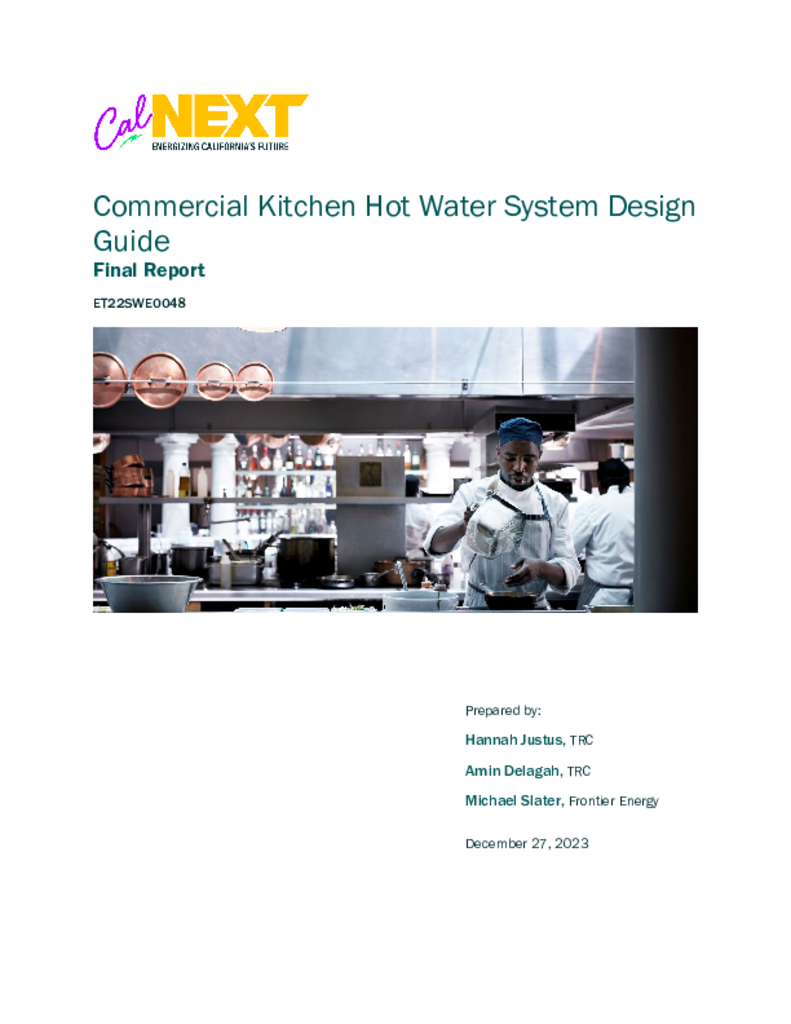ET22SWE0048 - Commercial Kitchen Hot Water System Design Guide

Water heating for food service applications represents 340M therms of gas consumption in California, and thus presents a significant opportunity for electrification, as well as significant efficiency improvements in retrofits and new construction applications. Public-facing design guides specific to improving hot water heating, delivery, and use in commercial kitchens are critical to restaurant operators, system designers, and other relevant audiences.
The current reference for design of commercial kitchen hot water systems in CA (Improving Commercial Kitchen Hot Water System Performance, 2010) is undergoing a 2022 revision. In this project, we will develop enhancements to the 2022 guide incorporating several advanced concepts including:
1) Addition of gas or electric HP assist concept and energy efficiency benefits versus conventional gas and electric heaters
2) A comparison of conventional gas and electric designs, compared to an optimized design
3) Electric and gas HP types and energy efficiency benefits
4) Heat pump incorporation considerations (e.g., ducting, noise, space, weight, and extra storage)
5) Single pass electric HP based designs such as the swing tank concept and parallel primary and temperature maintenance systems
6) The concept of heat pump 'assist'
7) Health department sizing considerations for heat pumps
8) Benefits of master mixing valves (for example: improvements in single-pass reliability when the recirculation return is plumbed to the primary storage tank)
For the proposed project, we will create an enhanced design guide intended for general audiences such as restaurant operators, with an added focus on heat pump (HP) considerations and concepts tailored to these audiences. We will also develop a technical design guide for a designer audience to help guide commercial kitchen designers and DHW system designers toward creating efficient and optimized systems.
The advanced design approaches outlined in the Design Guides produced by this project will reduce the majority of existing gas use for water heating by shifting the primary heating load responsibility to electric air-source commercial heat pumps. Air-source heat pumps operate at system coefficient of performance (COP) near 3 in this application while the existing heater is retained for regulatory requirements, redundancy, and maintaining the loop temperature with recirculation pumps. On-peak versus off-peak usage and demand management across equipment types will both be addressed in the load flexibility section of the design guide.
To supplement these guides, we will develop a slide deck accompanied by audio. To improve reach and language accessibility, both design guides will be translated into Spanish.
This project updates a 2022 design guide by including additional information to support decarbonization of commercial kitchen hot water systems. It also separates information into two guides for two different commercial kitchen stakeholders: designers and operators. PowerPoint slide decks for each guide are included and are accompanied by audio in both English and Spanish. Both guide versions in both languages have also been compiled into mp4 movie format for distribution to a wider audience.

